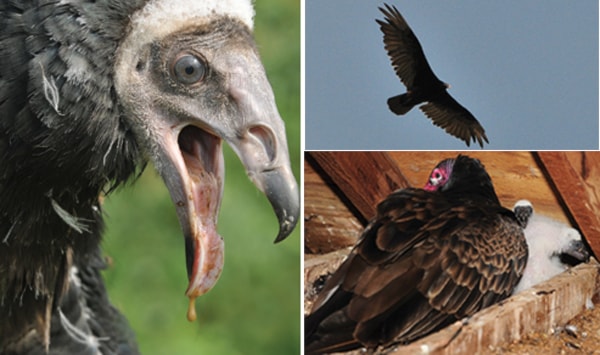Turkey vultures may be one of North America’s most under-appreciated bird, given their appearance and eating habits. But looks and diet can be deceiving.
They are unique creatures, well adapted to their role as nature’s clean-up crew.
And most interestingly, these maligned but gentle scavengers — immortalized in old cowboy movies by circling above a corpse sprawled on some southwestern desert — are becoming more common in Central Alberta.
In addition to being bald, ugly and partial to eating rotting flesh, turkey vultures have other unique habits.
One of the most unusual is that they relieve themselves directly on their legs. Apparently the excrement cools off their legs as it dries and since it is highly acidic, it kills off any bacteria that may collect on their limbs while they stand atop their fetid meals.
So potent are their stomach acids that the birds can tolerate some microbial toxins (e.g., botulism) and poisons (e.g., those used to kill coyotes and ground squirrels).
Turkey vultures can also vomit on demand! Vomiting helps deter nest predators (the vomit stings if it gets in the predator’s eyes). It also enables them to disgorge a heavy undigested meal so they can lift off should they be threatened by a predator while eating.
Unlike most birds, which rely on calls and songs to communicate with each other, turkey vultures can muster only grunts and hisses. So unimportant is song to them that they actually lack a voice box!
Grunts are commonly heard from hungry nestlings and between adults during courtship. If disturbed at their nest — typically in the attic of a creepy old building — the adults will make their presence known by issuing disembodied-sounding hisses accompanied by some eerie thumping.
I can only imagine how many times these ghostly displays have terrified unsuspecting visitors, who (like me) can’t resist the temptation to peek into an abandoned old house.
Turkey vultures have very keen sight but it is their amazingly acute sense of smell that most often alerts them to signs of death. Their olfactory lobes are large and complex, well adapted to detect even the slightest whiffs of rot.
Turkey vultures are increasing their range northward and westward in Alberta. Sighting them was once rare, but they are now seen on a fairly regular basis, gracefully riding the thermals along the Red Deer River valley and beyond.
Interesting research is being conducted on turkey vultures across the prairies. In Saskatchewan, GPS recorders have been used to track their long-distance migrations.
In Alberta, retired Fish and Wildlife biologist Dr Wayne Nelson, has been conducting very interesting research on their nesting habits and distribution. Dr. Nelson will be speaking about turkey vultures and his research at the Oct. 27th meeting of the Red Deer River Naturalists.
The meeting will be held at Kerry Wood Nature Centre and starts at 7:30 p.m. No admission charge. All are welcome.
Myrna Pearman is the Site Services Manager at Ellis Bird Farm. She can be reached at mpearman@ellisbirdfarm.ca
